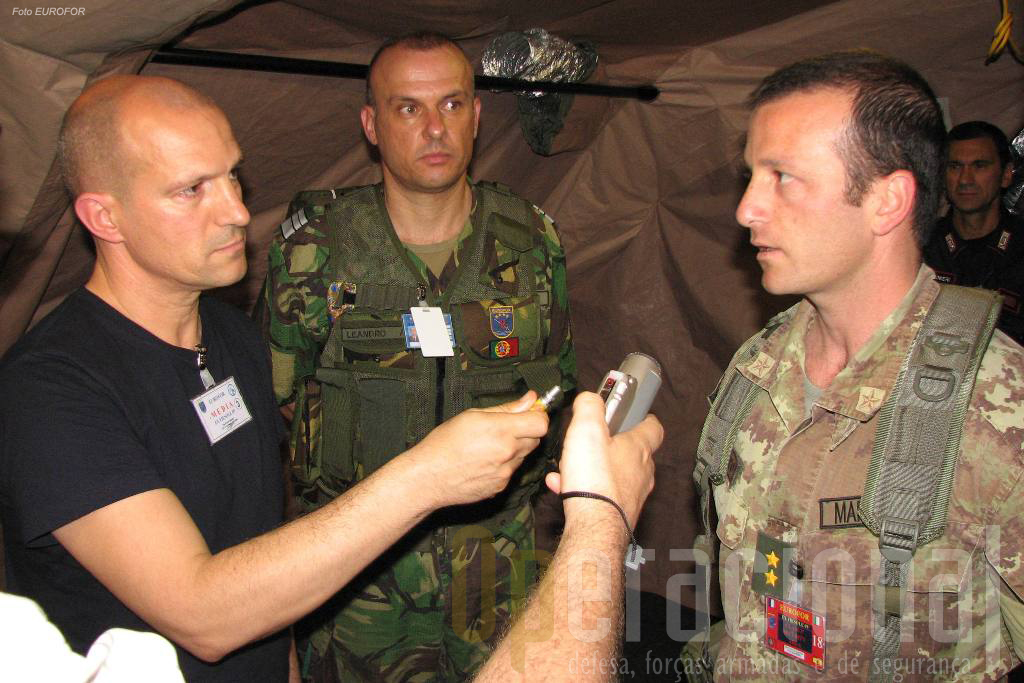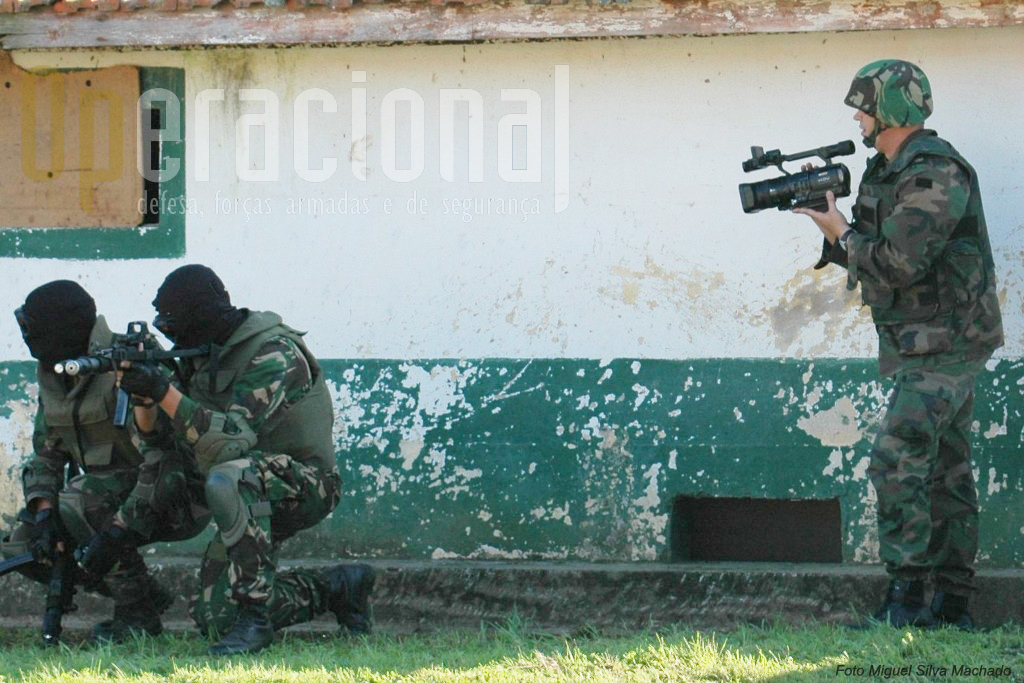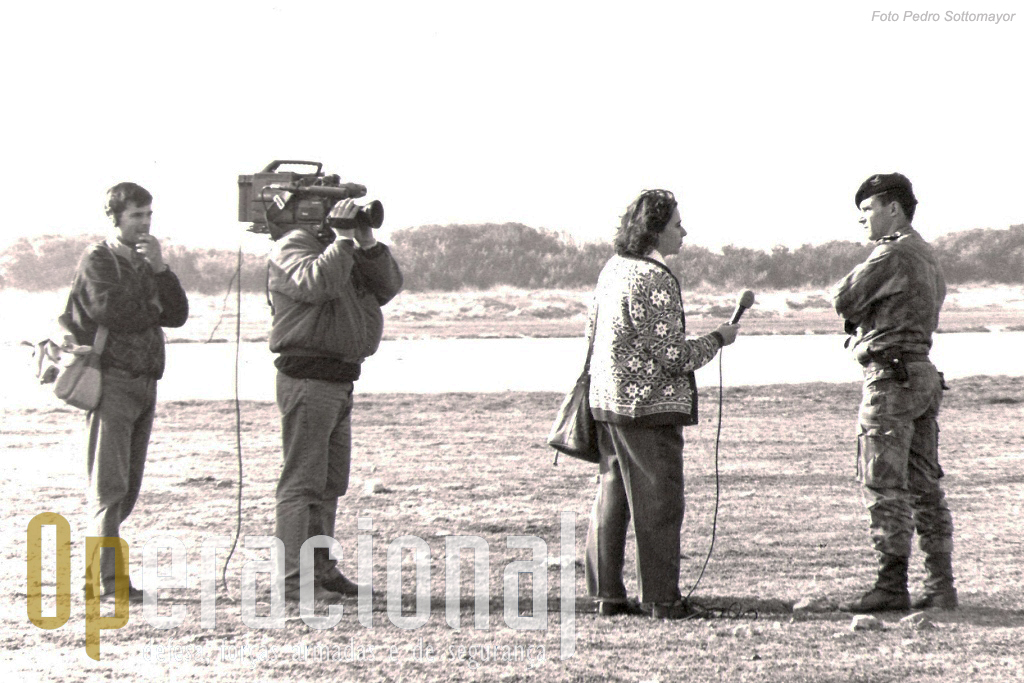MODERN MILITARY PUBLIC AFFAIRS
Por Miguel Machado • 20 Nov , 2009 • Categoria: 02. OPINIÃO Print
Print
Apresentamos hoje, pela primeira vez, um artigo em língua inglesa. A opinião que alguns dos nossos leitores militares, portugueses, colocados em comandos NATO, dentro e fora de Portugal, nos têm feito chegar, leva-nos a esta evolução. Tal é possível porque o Tenente-Coronel de Artilharia, Francisco José Leandro aceitou o convite que lhe dirigimos para este “arranque” com o presente artigo. Francisco Leandro é colaborador de longa data de publicações militares e académicas, nacionais e estrangeiras e, em paralelo com a sua carreira militar está a preparar a sua tese de doutoramento sobre um tema no âmbito do Direito Internacional Humanitário. Actualmente o TCor. Leandro é porta-voz da EUROFOR em Florença e tem dedicado a sua atenção e estudo a questões ligadas à comunicação, assunto a que os militares ligam cada vez mais. Mas não o suficiente na sua opinião como aqui ficará bem claro e em conformidade com essa opinião avança com pertinentes sugestões.
In modern military public affairs, armed conflicts are battles of perceptions
Words bear more power than a howitzer(1)
José de la Luz y Caballero (1800-1862)
The battlefield is the media.
Michael Bromley(2), 2004
Human beings are supposed to be rational creatures. Often while some strive to base decisions on thoughtful deliberations, others rush into impulses to mix reason and emotions. Media knows that. The reality is not always what we see. Nevertheless, being visually aware of the facts, even knowing that might not be the reality, images drive unconsciously rational creatures to be emotional and to reason based on that affecting state of mind. Moreover, audiences take decisions based on what they think they know and on what they don’t know, they don’t know (3). Media knows that!
Nowadays, to raise standing armies capable of delivering kinetic effects is getting more and more difficult and, even if an international actor would be able to do so, it would need to engage himself, sooner or later, in producing non-kinetic effects to magnify his ability to wind hearts and minds. Thus, the fight for perceptions miracle seems to merge “cheap” violent actions (to create drama) with “expensive” media coverage (to deliver it everywhere). Media also knows that!
Communication is a permanent activity of each human being, probably the most frequent and one of the upmost significance. When we walk in a crowd we find our way by using constantly unnoticed communication and perceptions. We don’t rationalize every single step. We do the same in many daily life situations. The same idea applies to “scooping”(4) and the so-called social media(5). These two features together brought to the new conflicts the “short”, the individual “empowering” and the “perceptions networking ability”. In fact, for traditional media it was compulsory to find the best media partner to pass an organizational or an individual message. Regardless the type of relation between those who wanted to communicate messages and the media agent, the relation itself had to exist. At the present time, and despite of the fact that from now and them this relation has to take place, each individual or organization have the possibility to convey immediately messages on his own, with the help of Internet tools. Furthermore, these new tools allow establishing networking, which somehow connects people longer than few instants watching TV or reading a newspaper. In addition, the consumer is not supposed to buy anything else to get information. Information is far as the touch of the power switch of individual computers. Information is there with us to think. Media is aware of that!
By knowing this, media has just learned how to take advantage of the opportunities offered by the new environment and is adjusting continuously to those opportunities. Consequently, to make a difference, at the present time, in public communication related matters, implies to understand, to accept and to act from fact that modern media has created a “thrilling sales formula“, that not only to takes advantage out of the new environment, but also gives to the new battles a different perspective:
 Public communication is more of an art form rather than a mathematical equation. Nevertheless, let’s see briefly each element of our gripping formula, which just serves an educational purpose.
Public communication is more of an art form rather than a mathematical equation. Nevertheless, let’s see briefly each element of our gripping formula, which just serves an educational purpose.
Data is basically media facts. But media facts are far from reality. Media facts are just single and circumstantial perspectives of the reality. Are mere pieces of reality. Facts might be comprehensive, complex, fake, appealing, neutral, related to other facts, they might be sourced reliable or merely a guess or an attempt to generate other facts. Facts can be farmed or taking by the perspective, but despite of that they are still purely media facts. Against facts only facts will prevail (6). Better, against media facts only consistent, clear, accurate and decisive facts might be successful. In a crisis communication to deliver data about actions that can save lives is far more important than to pass on data about the causes of the crisis itself. If facts are available, consistency out of diversity plays a very important role: “the many sides of the same coin“. When there are no media facts, media will create them just because facts are the modern media oxygen. Helpless people have a propensity to do helpless things, and when traditional media invest a huge amount of resources, facts are to be found almost at any cost. Social media does not require enormous investments to collect facts, only because is made by everyone with their own tools and equipments.
Deliver time might be measured from the moment the news is made available to the audience, until the moment the consumer gets it. It depends upon the deliver entity and the customer. Speed feeds the new media to be the first or, at least, to be different. Thus, we see every day that scooping are squeezing facts and decreasing accuracy. Media time is in love with sound bites as they are short, easy to pass away and generally not emotionally neutral. In fact, sound bites revealed an extraordinary ability to stay in the individual’s short-term memory helping to form networking perceptions. Sound bites are heavily consumed by SMS type of communication and its shortness calls for easy and fast conclusions. Nowadays, timely stands for transporting data, being quick, being the first, being unlike, being virtual and being everywhere if possible. Media is an instant, media is global and media is 24 hours accessible.
 Additionally, also the idea of having information ready to be consumed at a certain time is mainly related to professional and traditional media. Social media does not cope with pre-established timings, and this fact changes slightly the traditional scooping concept. Professors, judges, military commanders, bloggers, professional journalists or ordinary people have different perceptions of time. Each one makes it happen according to their own needs and possibilities. Furthermore, the empire of time also made modern (traditional and social) news highly dependent of technology. Thus, the tendency is leading “immediacy to overriding accuracy“.
Additionally, also the idea of having information ready to be consumed at a certain time is mainly related to professional and traditional media. Social media does not cope with pre-established timings, and this fact changes slightly the traditional scooping concept. Professors, judges, military commanders, bloggers, professional journalists or ordinary people have different perceptions of time. Each one makes it happen according to their own needs and possibilities. Furthermore, the empire of time also made modern (traditional and social) news highly dependent of technology. Thus, the tendency is leading “immediacy to overriding accuracy“.
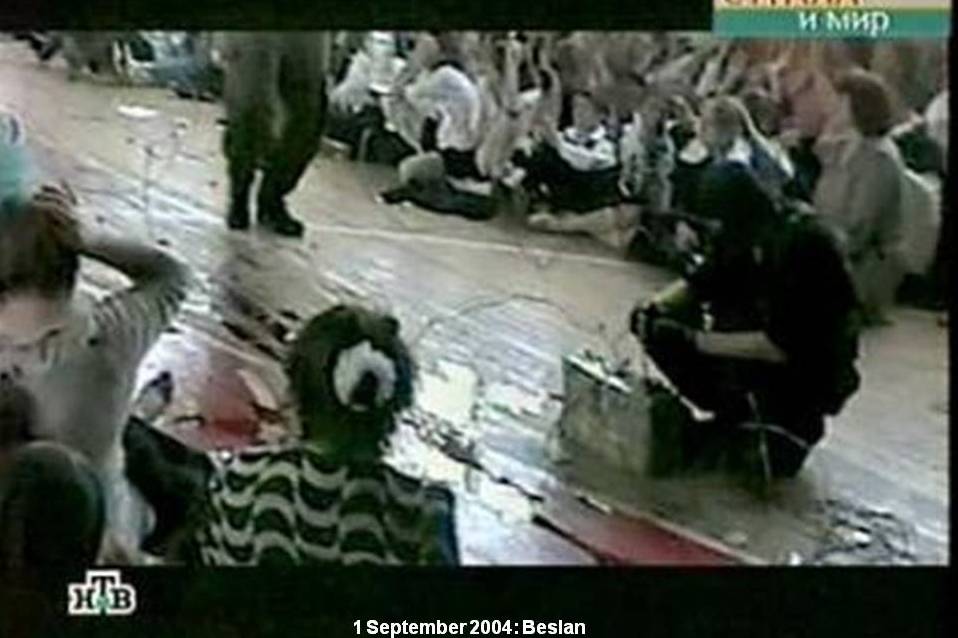
The most successful news is about conflict, violence, extreme risk, drastic changes, blood, scandal, sex and death. Therefore, the most successful news is just basic human instincts related. In short, they are about human emotions. Media emotions are produced either by words, by images or by a combination of both, aiming to drag the consumer virtually into the scene. Emotions are always a product of individual interpretation of ideas expressed by the media agent. Social media is also extremely powerful on producing emotions based on two main features: wording and imagery. The former grants each individual the opportunity to add (almost immediately) is own comments, bringing a new perspective and creating new emotions. The art of individual phrasing play a double role on this building process, once emotions are formed over emotions, exponentially and endlessly replicated. That’s what Internet software as twitter, facebook or blogging do. The later is due to the fact that each individual could share (also almost immediately) is angle, is perspective based on images. That’s what Internet software as Flicker does and what MMS technology for mobile phones or skipper technology provides.
In fact, there is a difference between wording and imagery. On one hand “images are emotional, visceral, and their impact is instantaneous. On the other, words, however, are received and interpreted in a linear fashion, and we are far better trained to be on our guard when responding to them. It will never be a fair contest between the two”(7). An image can convey emotions, thoughts, feelings, ideas, inspiration, tears or even events to which words alone sometimes cannot do justice. Images can make the difference dragging us into that perspective. With images we live the moment as if we were there. If the reality cannot be captured with images, it does not exist. They can inspire us, like the photo of the Olympic Flag at the games opening ceremony. Images can convey joy, like the images of the aftermath fall of Berlin wall, in 1989. They can inflame indignation, like the agonizing and unbearable photos of the Ormaska Camp in 1992; they can bring us face to face with the worst unimaginable inhumanities such as the Srebrenica events in 1995. They can be heartbreaking, like those of the young victims in Beslan School in 2004. They can bring tears to our eyes, lift our spirits or sink our hearts. Images are tremendously powerful and with such power must come responsibility for their prudent and thoughtful use(8). An image stays, a word goes away. Images bring the past to the present. Words are short but images give it all. Words apply to imagination but images are industrial fast food. Words convey logic and demand the usage of creation but images stir up emotions and change events quicker. “Images work because we don’t generally stop to analyse the implicit assumptions… they create.“(9). Here are a few interesting examples to explore among many others:
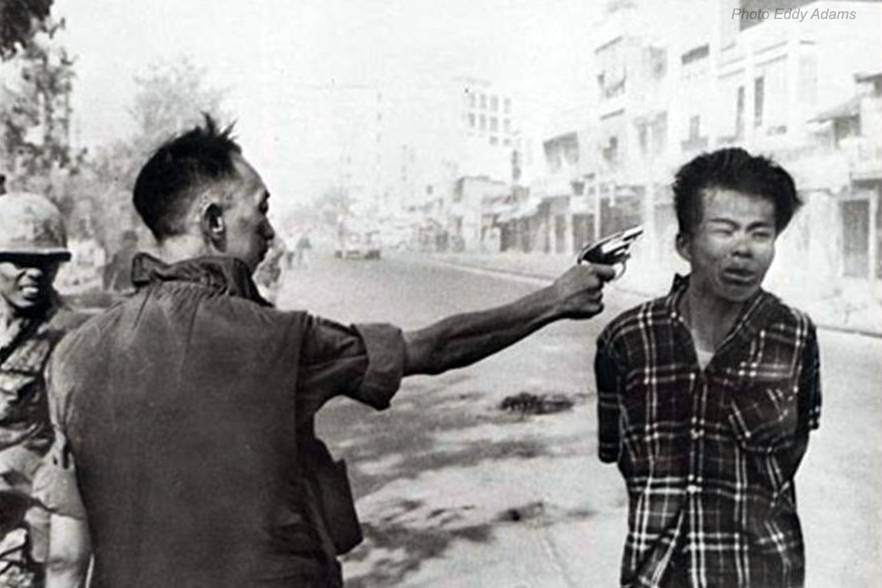
– When Eddie Adams, war photographer shoot the moment when the chief of Police in Saigon killed one “guerrilla” with his hands tied up. In the aftermath, Eddie Adams pronounced death the career of this police officer(10). He won the Pulitzer Award and we still bear in mind the image. This is the power that an image inherently possesses: might appeal for justice, might serve justice, or merely denounce injustice.
– When Steve McCurry photographed Sharbat Gula in 1984, she was 12, but by no means, anyone of them could image that National Geographic would published the photo, and likewise Steve McCurry had no idea about the ability to prolong the power of her eyes. This is the power that an image inherently possesses: it stays longer and appeals to imagination. It gives it existence.
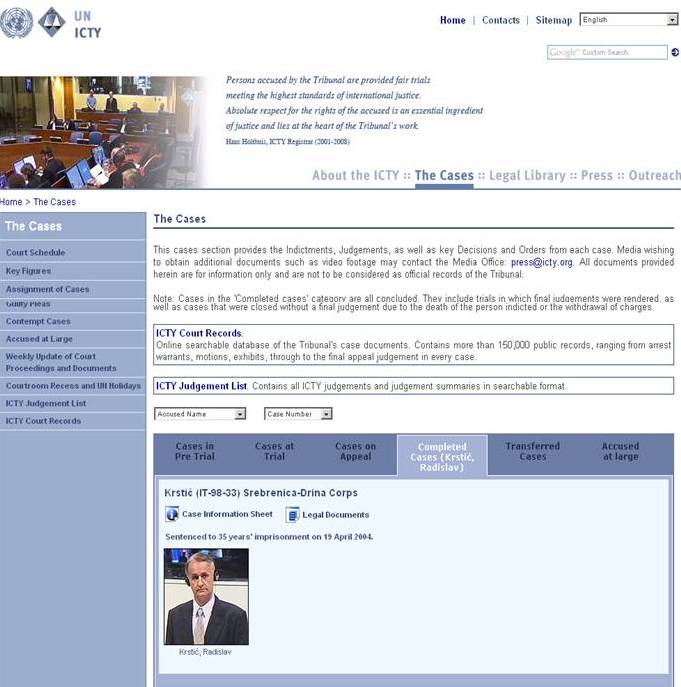
– When the International ad hoc Tribunal for former Yugoslavia (ICTY) displayed in its web page the photos of all war criminals, delivered power to the expression “criminal responsibility“. This is the power that an image inherently possesses: it carries immediate measurability of a distant reality. It turns the distance into presence.
I would say that the magic formula to communicate combines time, imagery and a short sound bite based on media facts (wording), and represents one of the most effective ways to deliver emotions. Nevertheless, I dare to state that without images there is no effective media news. “The dog beaten by the man” jeopardizes the dream of media neutrality. Soundly headlines, shocking images and a little explanation to explore the consumer emotions are purely other arrangements of the same argument.
Finally, equipped with these new perceptions, professional ethics plays a role. Ethics branches such as Kantianism, Aristotelism, Relativism, Absolutism, Utilitarianism, Pluralism, Egoism, Consequentialism or a combination of many help to understand, to describe, to face choices, to find comfort and will in times of adversity. Ethics is about conscious reflection on our moral beliefs and the purpose of your professional life. Ethics is about human beings facing choices and make them freely to achieve individual well-being. Furthermore, it guides the criticism, offers new solutions to new problems, helps to wonder, offers the joy of discovery and finds the right answer. Professional ethics helps to not drift away from our values and at the same time to fulfil our mission; it helps to avoid “close ups” taken from a face of young child in distress; it helps to avoid manufacturing the reality for the sake of the diverting communication; it helps to not cover a particular perspective, but to look the scene as a whole; it helps to discover the good and to cope with media pressure; it helps to minimize the harm and emphasize the respect for the suffering and it helps to bring justice and peace for all ( 1). Professional ethics does apply to every single military and media agent. Professional ethics does apply in all situations and all the time. Human beings are supposed to be ethical creatures as well. Media agents say that a picture is worth a thousand words. Media agents say that an emotional picture and a good sound bit together are what they are paid for. We say that a picture is worth a thousand words only if it brings dignity to all human beings. Fundamental rights can never pay the price of emotions. Professional ethics is about individual reputation and that is also a matter of perception. Media agents have to know that.
Military Headquarters need to understand that is no longer possible to control the bullets’ bearing of the XXIst century: the media news. The solution seems to be the ability to understand this new dimension and the new challenges coming out of it; that new challenges are calling for new doctrine; that the battle rhythm is now more demanding; and that the sophistication does not only lay on missiles but also on the art of visualization. Modern Armed Forces need to deal with the sophisticated storytelling adversary ability with means, capabilities, doctrine and ethics; they need to face the pressure of time, with the challenges of the digital world and with the simplicity of displacing images that can be accessed by everyone. Internet is the modern battlefield and media is a crucial part of this game. Not only because they deliver networking perceptions but also because of events such as the Stephens Farrell’s release in Afghanistan (2009), NATO Shelling Belgrade TV in Serbia (1999), the fake photos case published by Associated Press, Reuters, New York Times or US News Magazine in 2006 related to Lebanon and Gaza conflicts, or even the cases of Kangura Magazine in French and the Radio Mille Collines in Rwanda (1994), that crossed the traditional media neutrality line and where considered direct participation in the hostilities.

Internet is the perfect battlefield to explore the terrorism concept as a compulsory extension of the “killism” concept. It’s easy to do, low-price to afford, has the ability to be a weapon of mass perceptions, and consequently generates a major impact on individual perceptions. And that could be done by ammoniums “reporters” without being noticed or perceived.
Modern Armed Forces need to understand that image and speed together are weapons of mass perceptions; they need to understand the importance of using “maximum” information with “minimum” delay; they need to face the manufacturing of events that drag people to give more credit than the facts deserve by amplifying facts; they need to overcome this tendency brought by images to stop analysing the implicit assumption and associations; they need to realise that what is visual exists and drives who pays the bill. That’s why a lost opportunity to make the point does not return. Nowadays, visual assets are effective weapons with a huge collateral damages potential.
Just military combat camera teams and skilled spokespersons are not enough. Modern armies need to understand that before real world engagements, every soldier (and not only media military staff) should check their bullets(12),weapons, helmets, water, cameras, batteries and website accesses and review their drill on dealing with images, words and facts. Military have to be there, fighting on the perceptions battlefield, as part of the networking, displaying the products and contributing to born news. Military Public Affairs is no longer a one-man job or a stand-alone action. On the contrary, it is indeed, a common endeavour.
Military Public Affairs has to engage traditional and social media simultaneously, bringing the right messages, at the right time. Scrums(13) are also a virtual concept in the sense of having the networking followers claiming for information at the same time. Military have to be quicker, short and as accurate as possible without loosing the essential and using the most appropriated delivery means. Military have to understand that they win when the adversary is convinced to have lost, and that is also an emotional judgement. Military have to know that!
Contemporary media is a tremendously competitive industry. Modern news is an instant, an emotional instant, which modern organizations cannot afford to miss. If they do, their banking image and sometimes even their reputation will pay the price. In fact, modern warfare deals decisively with media industry and individual perceptions in the way that might not be a second opportunity, if failing to spot positively the first one. Is it fair to accepted that both military and media know that news are made of a mathematical equation, in which art paves good part of the way towards perceptions.
(1) In Spanish: “La palavra es más poderosa que el canon”.
(2) Professor Michael Bromley is the Head of the School of Journalism and Communication and Professor of Journalism. He is a former journalist and has worked for a number of daily newspapers in the United Kingdom, including the Daily Mail, for more than 20 years. He has taught Journalism and Media Studies at universities in the United Kingdom, in the United States of America, where he was Howard R. Marsh Visiting Professor of Journalism at the University of Michigan, and Australia. He has published widely on journalism and the media, especially the press. He joined the School of Journalism and Communication in October 2004 as Deputy Head of University of Queensland and was appointed Head in August 2007.
(3) This expression has been attributed to the former US Secretary of State Donald Rumsfeld.
(4) Is a traditional media expression associated to the idea of speeding news in the sense of being them first, and if possible, in that special and unique perspective.
(5) Traditional media stands for the use of TV, radio, newspapers, magazines, billboards, SMS and MMS, flyers, posters, face to face, video messages and alike. Social media refers to Internet related tools, which nowadays are empowering individuals. Among these tools are the electronic newspapers, Flicker, Twitter, MySpace, Facebook and Internet blogs.
(6) A very good example, among many others, is the following: in November 2009 the BBC World organised a debate at the Westminster Abbey (United Kingdom) in order to find out about a specific point. The debate was broadcasted around the world several times, between 7th and 8th of November 2009. Around 2000 people were invited to attend live the event. The query was “Is the Catholic Church a force for good in the world?” Only four statements were accepted and all of them had a very limited time available. Two statements supported the motion and two other were against the motion. The later won by far. Two very well intentioned statements, based on rationality and faith, supported the supporting motion. The winners ran against motion based on facts, extremely positive body language statements, and common sense sound bites. (www.intelligencesquared.com).
(7) Cori E Dauber Military Review, January – February 2009, pg 23.
(8) http://www.buzzle.com/articles/power-of-an-image.html (172230FEB09)
(9) Cori E Dauber Military Review, January – February 2009, pg 23.
(10) Eddie Adams stated: “The General killed the Vietcong and I killed the General’s career with my camera. Photos are the most powerful weapons in the world”.
(11) Inspired by the Society of Professional Journalists Code of Ethics, adopted in 1996.
(12) Sometimes the bullets are just”footage”, products prepared in advance to fill the media gaps and the need to tell, to know, to see and to show.
(13) The expression “scrum” is used in the sport of rugby and stands for a group of attacking players from each team who come together with their heads down and arms joined, and push against each other, trying to gain control of the ball (according to 3rd Edition Cambridge Advance Learners Dictionary). In media terms, the same expression “scrum”, stands for a situation when a guest is, suddenly and unexpectedly, surrounded by journalists trying to get a statement, all at the same time.
Miguel Machado é
Email deste autor | Todos os posts de Miguel Machado

